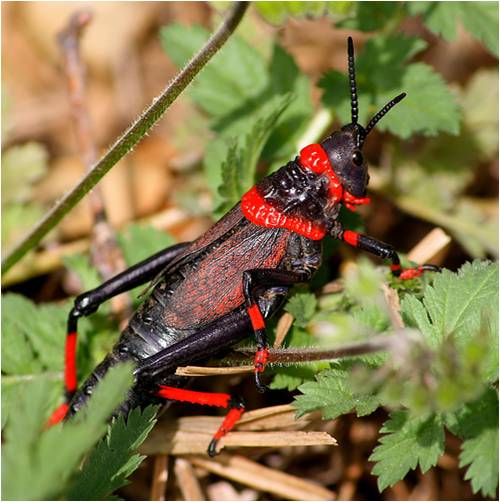It seems that the Walter Sisulu Botanical Gardens is a popular place, especially for pensioners on a Tuesday, and being part of that group, my wife and I were walking towards the falls a few weeks ago when we saw a very striking insect strolling across the path, with apparently no concern for being out in the open and therefore vulnerable to predators.
Whilst I had seen them before, I had no idea what it was called or even if it was a grasshopper or a locust. Which was a bit embarrassing, as, seeing as I have done the Bushveld Mosaic course my wife expects me to know the name of everything. So decided it was time to do a bit of research.
SPOILER WARNING.
Here is the picture, but before reading any further, Do you know what it is called, and what is the difference between a grasshopper and a locust?

Photo: (c) Kyknoord, some rights reserved (CC BY)
What is It?
The answer to question one is Dictyophorus spumans, Koppie foam grasshopper, or rooibaadjie. Which is a species of grasshopper indigenous to Africa. The name “foaming grasshopper” derives from the insect’s ability to produce a toxic foam from its thoracic glands.
It grows up to a length of 80mm. The neck shield has a warty surface, and their colour is highly variable. It is toxic due to the poisons that it sequesters from its diet, which includes a large number of toxic and distasteful plants such as milkweed.
Which explains why it wasn’t too worried about being some birds meal.
Which is it?
When I first saw it, my immediate thought was “Locust” based on its size, but obviously the name indicates that this is not the case. So what is the difference between the two?
In a 2010 article on locusts that was published in the Encyclopedia of Animal Behaviour, Alexandre Vsevolo Latchininsky, Extension Entomologist for the State of Wyoming, explains that “all locusts are grasshoppers but not all grasshoppers are locusts.” He defines locusts as “short-horned grasshoppers (Orthoptera: Acrididae), distinguished by their density-dependent behavioral, physiological, and phenotypic polymorphism.”
Or in simpler English, from the website http://www.actforlibraries.org/
Locusts, are part of a large group of insects called grasshoppers. They differ from grasshoppers in terms of:
- a) Size
They are larger than grasshoppers. An adult locust can grow to a length of 3 inches.
- b) Behaviour
At times, locusts are solitary or individual insects with the lifestyle the same as those of grasshoppers. Their behaviour, however, can change from being solitary to forming a large group. This behavioural phase is called the gregarious phase.
- c) Colour
The appearance of a solitary or individual adult locust is usually brown in colour. In the case of gregarious adults, the appearance changes from brown to pink (immature) and yellow (mature).
- d) Coverage of distance
Locusts cover vast distances. The most notable distances covered by a swarm of locusts was in 1954 when they flew from North-West Africa to Great Britain. In 1988, a swarm covered a distance of 5,000km in ten days from West Africa to Caribbean.
So whilst our Koppie foam certainly meets the size criteria, he does not fit the colour, and most likely the behavioural requirements to be a locust.








